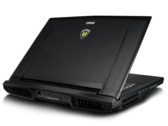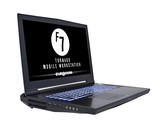
MSI WT75 8SM (Xeon E-2176G, Quadro P5200) Workstation Review
Intel Xeon E-2176G | NVIDIA Quadro P5200 | 17.30" | 4.1 kg

The Nvidia Quadro P5200 is a mobile high-end workstation graphics card for laptops. Similar to the consumer GeForce GTX 1080 (Laptop), it is based on a GP104 chip with 2560 shaders but uses a bit slower GDDR5 instead of GDDR5X of the GTX1080. The Quadro P5200 ist the successor to the Quadro P5000. There will be a normal (Max-P) and a slower but more efficient (Max-Q) variant of the card. For the Max-P variant, the clock speeds are specified from 1556 (base) to 1746 MHz (Boost), the power efficient Max-Q clocks from 1316 MHz (base) to 1569 (Boost) according to a GPU-Z screenshot from a reader (-15% / -10%). The 16 GB GDDR5 are clocked at 3,6 GHz leading to a memory bandwidth of 230 GB/s.
The Quadro GPUs offer certified drivers, which are optimized for stability and performance in professional applications (CAD, DCC, medical, prospection, and visualizing applications). The performance in these areas is therefore much better compared to corresponding consumer GPUs.
Performance
The theoretical performance should be a bit above the older Quadro P5000. Altough the clock speed increase is not yet known, the power consumption is rumored to be a lot higher, which should lead to a noticable improved performance. Nvidia specifies a theoretical peak performance of 8,9 GFLOPS (Single Precision).
Power Consumption
The power consumption of the Quadro P5200 is specified by Nvidia as 150 Watt (Max-P) and rumored to be 100 - 110 Watt for the Max-Q variant. Therefore, it is a lot higher than the Quadro P5000 versions (100 Watt and 80 Watt).
Quadro P Series
| ||||||||||||||||||||||||||||||||||||||||
| Architecture | Pascal | |||||||||||||||||||||||||||||||||||||||
| Pipelines | 2560 - unified | |||||||||||||||||||||||||||||||||||||||
| Core Speed | 1316 - 1569 (Boost) MHz | |||||||||||||||||||||||||||||||||||||||
| Memory Speed | 7216 MHz | |||||||||||||||||||||||||||||||||||||||
| Memory Bus Width | 256 Bit | |||||||||||||||||||||||||||||||||||||||
| Memory Type | GDDR5 | |||||||||||||||||||||||||||||||||||||||
| Max. Amount of Memory | 16 GB | |||||||||||||||||||||||||||||||||||||||
| Shared Memory | no | |||||||||||||||||||||||||||||||||||||||
| API | DirectX 12_1, Shader 5.0, OpenGL 4.5 | |||||||||||||||||||||||||||||||||||||||
| Power Consumption | 150 Watt | |||||||||||||||||||||||||||||||||||||||
| technology | 16 nm | |||||||||||||||||||||||||||||||||||||||
| Features | Optimus, PhysX, 3D Vision Pro, nView, Optimus | |||||||||||||||||||||||||||||||||||||||
| Notebook Size | large | |||||||||||||||||||||||||||||||||||||||
| Date of Announcement | 11.01.2017 | |||||||||||||||||||||||||||||||||||||||
The following benchmarks stem from our benchmarks of review laptops. The performance depends on the used graphics memory, clock rate, processor, system settings, drivers, and operating systems. So the results don't have to be representative for all laptops with this GPU. For detailed information on the benchmark results, click on the fps number.















| low | med. | high | ultra | QHD | 4K | |
|---|---|---|---|---|---|---|
| Shadow of the Tomb Raider | 147 | 91 | 84 | 72 | 26 | |
| F1 2018 | 212 | 152 | 125 | 83 | 46 | |
| Monster Hunter World | 183.5 | 110.1 | 100.4 | 77.4 | 24.1 | |
| Destiny 2 | 13 | 12.7 | 12.6 | 12.2 | 12.3 | |
| Middle-earth: Shadow of War | 219 | 137 | 106 | 84 | 33 | |
| Dirt 4 | 354.1 | 221.2 | 126 | 84.4 | 56.8 | |
| Rocket League | 248.5 | 247 | 185.8 | 92.5 | ||
| Prey | 145 | 144.6 | 145 | 144.1 | 60.9 | |
| Overwatch | 300 | 300 | 252.2 | 174.1 | 88.7 | |
| Ashes of the Singularity | 113 | 99.1 | 97.8 | 43.5 | ||
| Rise of the Tomb Raider | 291 | 215 | 124 | 103 | 46 | |
| Fallout 4 | 241.9 | 236.3 | 46.8 | |||
| Metal Gear Solid V | 60 | 60 | 60 | 60 | 60 | |
| Batman: Arkham Knight | 186 | 176 | 131 | 90 | 50 | |
| The Witcher 3 | 315 | 220 | 118 | 65 | 46 | |
| Thief | 149.4 | 145.1 | 145.7 | 114.2 | ||
| Metro: Last Light | 177.5 | 175.2 | 171.6 | 119.2 | ||
| BioShock Infinite | 415 | 359 | 331 | |||
| StarCraft II: Heart of the Swarm | 753 | 346.2 | 296.6 | 218.9 | ||
| Guild Wars 2 | 145.1 | 83.5 | 85.4 | |||
| Sleeping Dogs | 344.2 | 288.1 | 267.3 | 118.8 | ||
| low | med. | high | ultra | QHD | 4K | < 30 fps < 60 fps < 120 fps ≥ 120 fps | 1 2 18 | 1 4 15 | 1 7 12 | 1 13 3 | | 3 8 4 |
For more games that might be playable and a list of all games and graphics cards visit our Gaming List
| Model (Max-P) | Cores | TFLOPS |
|---|---|---|
| Quadro P5200 | 2560 | 8.9 |
| Quadro P4200 | 2304 | 7.6 |
| Quadro P3200 | 1792 | 5.3 |
| Quadro P2000 | 768 | 2.5 |
| Quadro P1000 | 512 | 1.6 |
| Quadro P600 | 384 | 1.2 |
| Quadro P500 | 256 | 0.5 |


HP ZBook 17 G5-4RA65UT-ABA: Intel Xeon E-2186M, 17.30", 3.2 kg
External Review » HP ZBook 17 G5-4RA65UT-ABA
Lenovo ThinkPad P72-20MB0000PB: Intel Xeon E-2186M, 17.30", 3.4 kg
External Review » Lenovo ThinkPad P72-20MB0000PB
Fujitsu Celsius H980: Intel Core i7-8850H, 17.30", 3.5 kg
External Review » Fujitsu Celsius H980
Dell Precision 7730, i9-8950HK, Nvidia Quadro P5200: Intel Core i9-8950HK, 17.30", 3.2 kg
External Review » Dell Precision 7730, i9-8950HK, Nvidia Quadro P5200
» Comparison of GPUs
Detailed list of all laptop GPUs sorted by class and performance.
» Benchmark List
Sort and restrict laptop GPUs based on performance in synthetic benchmarks.
» Notebook Gaming List
Playable games for each graphics card and their average FPS results.
Top 10 Laptops
Multimedia, Budget Multimedia, Gaming, Budget Gaming, Lightweight Gaming, Business, Budget Office, Workstation, Subnotebooks, Ultrabooks, Chromebooks
under 300 USD/Euros, under 500 USD/Euros, 1,000 USD/Euros, for University Students, Best Displays
Top 10 Smartphones
Smartphones, Phablets, ≤6-inch, Camera Smartphones